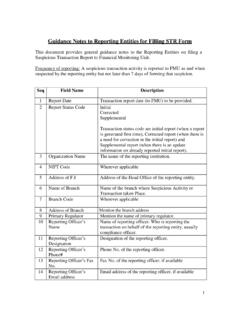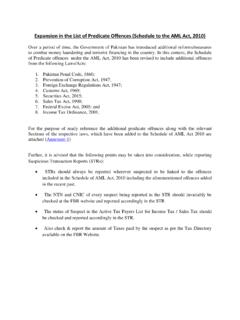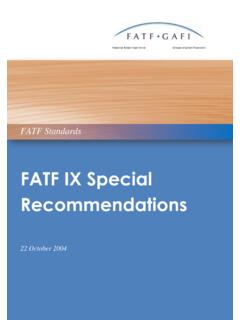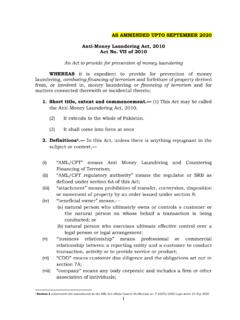Transcription of Financial Monitoring Unit Frequently Asked Questions (FAQs ...
1 Page 1 of 6 Financial Monitoring Unit Frequently Asked Questions ( faqs ) on Currency Transaction Reports (CTRs) Financial Monitoring Unit (FMU) has prepared Frequently Asked Questions ( faqs ) to provide assistance to the reporting entities relating to the submission/ reporting of Currency Transaction Reports (CTRs). 1) What is a Currency Transaction Report? A Currency Transaction Report is a threshold based report of cash transaction undertaken by the customers of reporting entities . A CTR has been defined under Section 2(c) of AML Act 2010, according to which, a CTR is a report on currency transaction of such an amount as may be specified by the National Executive Committee by notification in the official Gazette.
2 Section 5 of AML Regulations 2015 further explains that the CTR is filed when a cash-based transaction involving payment, receipt, or transfer of an amount, as specified by the National Executive Committee, on a prescribed format. As per Gazette notification SRO 73 (I)/2015 dated 21-01-2015, the minimum amount for reporting a CTR to FMU is two million rupees. Accordingly, all cash-based transactions of two million rupees or above involving payment, receipt, or transfer are to be reported to FMU as CTR. Likewise, cash-based foreign currency transaction equivalent to two million rupees or above are to be reported as CTR.
3 Every single cash transaction of two million rupees or above is to be reported as CTR. Aggregation of cash transactions during the day for the purpose of reporting a CTR is not required. However, if there is a suspicion that the customer is structuring the transaction into several broken cash transactions to evade reporting of CTR, the same may be reported in the form of Suspicious Transaction Report. The reporting entities are required to report CTR immediately, but no later than seven working days as provided in the Section 7(3) of AML Act 2010 Page 2 of 6 2) Which Section of AML Act, 2010 requires reporting of CTR?
4 Section 7(3) of the AML Act 2010 creates obligation on reporting entities to file CTR with FMU in the manner prescribed by the FMU. 3) Who must report CTR as per provisions of the AML Act 2010? In terms of Section 7(3) of AML Act, 2010 (as amended in December 2015) reporting entities are required to file CTRs with FMU. As per Section 2(u) of AML Act, 2010 reporting entity includes Financial institutions as defined in Section 2 (f) and Non- Financial Businesses & Professions as defined in Section 2(m): Financial Institution Financial Institution includes any institution carrying on any one or more of the following activities, namely:- (i) acceptance of deposits and other repayable funds from the public; (ii) lending in whatsoever form; (iii) Financial leasing; (iv) money or value transfer.
5 (v) issuing and managing means of payments including but not limited to credit and debit cards, cheques, traveler s cheques, money orders, bank drafts and electronic money; (vi) Financial guarantees and commitments; (vii) trading in (a) money market instruments ; (b) foreign exchange (c) exchange, interest rate and index instruments; (d) transferable securities (e) commodity futures trading. (viii) participation in shares issues and the provision of services related to such issues; (ix) individual and collective portfolio management; (x) safekeeping and administration of cash or liquid securities on behalf of other persons; (xi) investing, administering or managing funds or money on behalf of other persons; (xii) insurance business transactions; Page 3 of 6 (xiii) money and currency changing; and (xiv) carrying out business as intermediary.
6 Non- Financial Businesses & Professions Non- Financial Businesses and Professions means real estate agents, jewelers, dealers in precious metals and precious stones, lawyers, notaries and other legal professionals, accountants, trust and company service providers and such other non- Financial businesses and professions as may be notified by the Federal Government. The same can be accessed at below mentioned link: 4) What is the threshold for reporting the CTRs? At present, the threshold for reporting of CTRs is two million rupees or above (or equivalent amount in foreign currency as per prevailing exchange rate) 5) What should be the frequency of reporting CTRs?
7 In order to cater the large inflow of emails and to streamline the process of reporting of CTRs, the frequency for reporting of CTRs had been set, in consultation with the Financial institutions, on weekly basis ONE (1) email/week containing all of CTRs of the preceding week. The reporting entities would combine all the CTRs from the preceding week (5/6 working days) into a single encrypted file to be emailed to FMU on the following Monday. 6) Is there any standard format for reporting of CTR? Yes. CTRs are to be reported in line with standard format circulated vide AML regulations 2015.
8 All the Financial institutions are, however, required to file CTRs in electronic format as per procedure already shared with them. Manual reporting of CTRs by Financial institutions is no more permissible except in special circumstances with the permission of FMU. Page 4 of 6 7) How can we get confirmation from FMU on filing of the CTRs? An acknowledgement from FMU, via return email, is sent which confirms the receipt of CTRs. In case acknowledgement is not received due to some technical reason, the same can be confirmed from the relevant desk officer in FMU.
9 8) What is to be done if transactions relating to exchange of multiple currencies aggregate to two million rupees or above? reporting of transactions where multiple currencies are exchanged and aggregated amount is two million rupees or above, the CTR would be reported where the Transaction Capturing System aggregates all the currencies exchanges as one transactions, otherwise, if the individual currency exchanges are less that two million rupees, the same would not require reporting of CTR in the given context. Example: An individual brings 20,000 USD (eq.
10 To PKR 2,100,000) and 10,000 Euros (Eq. to PKR 1,180,000) for exchange. If the transaction capturing system of the exchange company captures these transactions as a combined single transaction then the net reporting amount to FMU would be PKR 3,280,000/- however if the transaction Monitoring system of the exchange company takes these two separate transactions depending on the number of currencies being exchanged then only the transaction of USD being above the reporting threshold would be reported to FMU. However, if there is a suspicion that the customer is structuring the transactions to evade reporting of CTR, the same may be reported in the form of STR.




